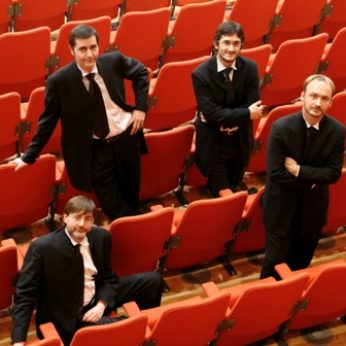Composer: Wolfgang Amadeus Mozart (b. 1756 - d. 1791)
Performance date: 01/07/2013
Venue: St. Brendan’s Church
Composition Year: 1786
Duration: 00:32:51
Recording Engineer: Damian Chennells, RTÉ lyric fm
Instrumentation: 2vn, va, vc
Instrumentation Category:String Quartet
Artists:
Quatuor Danel (Marc Danel, Gilles Millet [violins], Vlad Bogdanas [viola], Guy Danel [cello]) -
[quartet]

Anton Hoffmeister [1754-1812] was a
popular composer in
and owner of a publishing company specialising in chamber music. A friend of Mozart, he published number of
his works including this D Major Quartet, although he was later unsure of the
wisdom of his decision as the public
found the work too hard and refused to purchase it. Unlike other quartets issued in sets of six,
this was a one-off score and the name of its publisher has long been attached
to it. Perhaps it was a commission but
there is little information available about its conception. Mozart completed the Quartet in August 1786
in
couple of months after the première of Figaro.
The lengthy opening movement occupies
almost half the Quartet’s duration and has a suave elegance about it. The first
theme contains all the material for the movement with Mozart fashioning a kind
of second subject from a variation of the theme. Haydn had been creating
monothematic movements at that time and perhaps Mozart was influenced by
this. It is a finely crafted piece with
remarkable canons and other polyphonic touches.
It is the short, second movement Minuet which had brought most critical
acclaim to the Quartet: Albert Einstein
hailed it as unique, while Robbins Landon described it as one of the most original in 18th
century music. The tune is a lusty
country dance, more of a Ländler than a courtly Minuet, while the contrasting central section is a
sparkling creation, described by Einstein as a piece of musical wizardry.
a sighing, amorous theme. It is one of Mozart’s most personal statements, full
of a deeply-felt emotion. In contrast
the fourth movement is in Mozart’s opera buffa style, as with a number of his
Piano Concerto finales. An initially hesitant theme bursts into vigorous action
and the movement whirls away, like an ensemble from some comic opera, full of felicitous
moments and good cheer.
Copyright © 2025 West Cork Music. All rights reserved.
Designed and developed by Matrix Internet